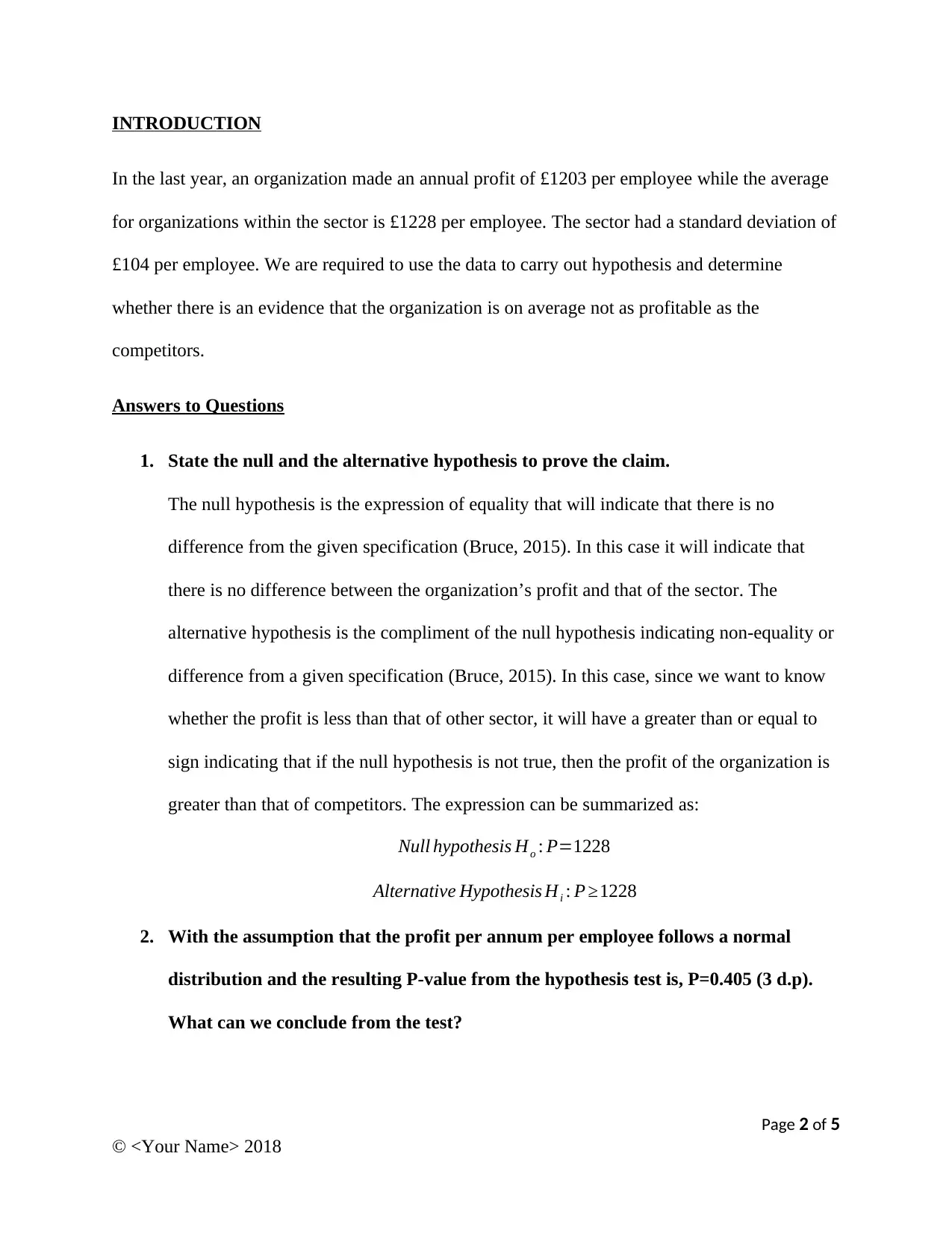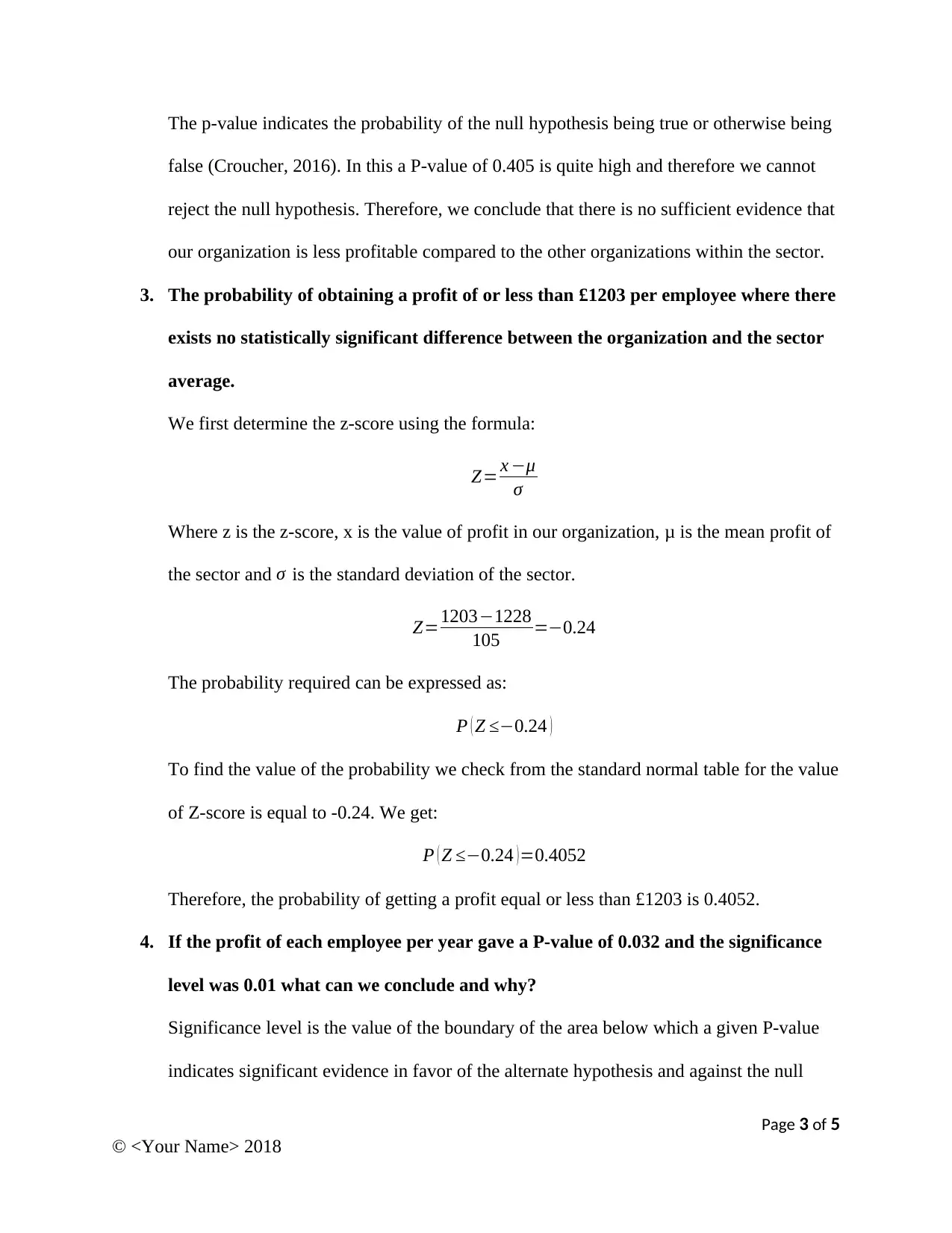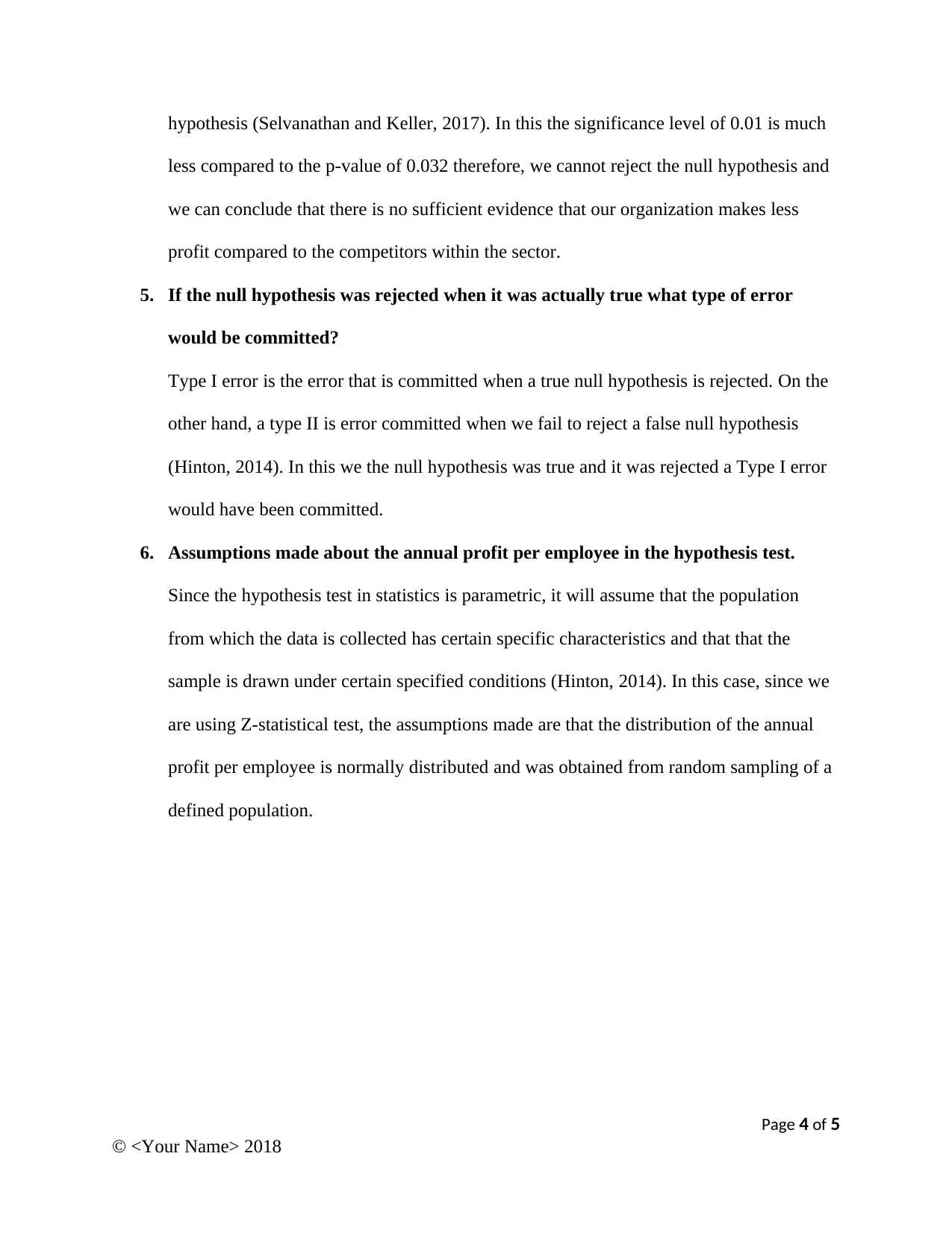Business Research Methodology Assignment: Hypothesis Testing
VerifiedAdded on 2021/10/16
|5
|845
|124
Homework Assignment
AI Summary
This document presents a solution to a business research methodology assignment, focusing on hypothesis testing and statistical analysis within a business context. The assignment addresses a scenario where an organization's profitability is compared to the industry average. The solution includes formulating null and alternative hypotheses, interpreting p-values, calculating z-scores, and determining the significance of the results. It also explores the implications of Type I errors and the assumptions underlying the statistical tests. The document utilizes relevant statistical concepts to analyze the provided data and draw conclusions about the organization's financial performance relative to its competitors. The solution demonstrates an understanding of statistical principles and their application in business decision-making, supported by cited references.

University
Business Research Methodology
By
Your Name
Date
Page 1 of 5
© <Your Name> 2018
Business Research Methodology
By
Your Name
Date
Page 1 of 5
© <Your Name> 2018
Paraphrase This Document
Need a fresh take? Get an instant paraphrase of this document with our AI Paraphraser

INTRODUCTION
In the last year, an organization made an annual profit of £1203 per employee while the average
for organizations within the sector is £1228 per employee. The sector had a standard deviation of
£104 per employee. We are required to use the data to carry out hypothesis and determine
whether there is an evidence that the organization is on average not as profitable as the
competitors.
Answers to Questions
1. State the null and the alternative hypothesis to prove the claim.
The null hypothesis is the expression of equality that will indicate that there is no
difference from the given specification (Bruce, 2015). In this case it will indicate that
there is no difference between the organization’s profit and that of the sector. The
alternative hypothesis is the compliment of the null hypothesis indicating non-equality or
difference from a given specification (Bruce, 2015). In this case, since we want to know
whether the profit is less than that of other sector, it will have a greater than or equal to
sign indicating that if the null hypothesis is not true, then the profit of the organization is
greater than that of competitors. The expression can be summarized as:
Null hypothesis Ho : P=1228
Alternative Hypothesis Hi : P ≥1228
2. With the assumption that the profit per annum per employee follows a normal
distribution and the resulting P-value from the hypothesis test is, P=0.405 (3 d.p).
What can we conclude from the test?
Page 2 of 5
© <Your Name> 2018
In the last year, an organization made an annual profit of £1203 per employee while the average
for organizations within the sector is £1228 per employee. The sector had a standard deviation of
£104 per employee. We are required to use the data to carry out hypothesis and determine
whether there is an evidence that the organization is on average not as profitable as the
competitors.
Answers to Questions
1. State the null and the alternative hypothesis to prove the claim.
The null hypothesis is the expression of equality that will indicate that there is no
difference from the given specification (Bruce, 2015). In this case it will indicate that
there is no difference between the organization’s profit and that of the sector. The
alternative hypothesis is the compliment of the null hypothesis indicating non-equality or
difference from a given specification (Bruce, 2015). In this case, since we want to know
whether the profit is less than that of other sector, it will have a greater than or equal to
sign indicating that if the null hypothesis is not true, then the profit of the organization is
greater than that of competitors. The expression can be summarized as:
Null hypothesis Ho : P=1228
Alternative Hypothesis Hi : P ≥1228
2. With the assumption that the profit per annum per employee follows a normal
distribution and the resulting P-value from the hypothesis test is, P=0.405 (3 d.p).
What can we conclude from the test?
Page 2 of 5
© <Your Name> 2018

The p-value indicates the probability of the null hypothesis being true or otherwise being
false (Croucher, 2016). In this a P-value of 0.405 is quite high and therefore we cannot
reject the null hypothesis. Therefore, we conclude that there is no sufficient evidence that
our organization is less profitable compared to the other organizations within the sector.
3. The probability of obtaining a profit of or less than £1203 per employee where there
exists no statistically significant difference between the organization and the sector
average.
We first determine the z-score using the formula:
Z= x −μ
σ
Where z is the z-score, x is the value of profit in our organization, μ is the mean profit of
the sector and σ is the standard deviation of the sector.
Z=1203−1228
105 =−0.24
The probability required can be expressed as:
P ( Z ≤−0.24 )
To find the value of the probability we check from the standard normal table for the value
of Z-score is equal to -0.24. We get:
P ( Z ≤−0.24 )=0.4052
Therefore, the probability of getting a profit equal or less than £1203 is 0.4052.
4. If the profit of each employee per year gave a P-value of 0.032 and the significance
level was 0.01 what can we conclude and why?
Significance level is the value of the boundary of the area below which a given P-value
indicates significant evidence in favor of the alternate hypothesis and against the null
Page 3 of 5
© <Your Name> 2018
false (Croucher, 2016). In this a P-value of 0.405 is quite high and therefore we cannot
reject the null hypothesis. Therefore, we conclude that there is no sufficient evidence that
our organization is less profitable compared to the other organizations within the sector.
3. The probability of obtaining a profit of or less than £1203 per employee where there
exists no statistically significant difference between the organization and the sector
average.
We first determine the z-score using the formula:
Z= x −μ
σ
Where z is the z-score, x is the value of profit in our organization, μ is the mean profit of
the sector and σ is the standard deviation of the sector.
Z=1203−1228
105 =−0.24
The probability required can be expressed as:
P ( Z ≤−0.24 )
To find the value of the probability we check from the standard normal table for the value
of Z-score is equal to -0.24. We get:
P ( Z ≤−0.24 )=0.4052
Therefore, the probability of getting a profit equal or less than £1203 is 0.4052.
4. If the profit of each employee per year gave a P-value of 0.032 and the significance
level was 0.01 what can we conclude and why?
Significance level is the value of the boundary of the area below which a given P-value
indicates significant evidence in favor of the alternate hypothesis and against the null
Page 3 of 5
© <Your Name> 2018
⊘ This is a preview!⊘
Do you want full access?
Subscribe today to unlock all pages.

Trusted by 1+ million students worldwide

hypothesis (Selvanathan and Keller, 2017). In this the significance level of 0.01 is much
less compared to the p-value of 0.032 therefore, we cannot reject the null hypothesis and
we can conclude that there is no sufficient evidence that our organization makes less
profit compared to the competitors within the sector.
5. If the null hypothesis was rejected when it was actually true what type of error
would be committed?
Type I error is the error that is committed when a true null hypothesis is rejected. On the
other hand, a type II is error committed when we fail to reject a false null hypothesis
(Hinton, 2014). In this we the null hypothesis was true and it was rejected a Type I error
would have been committed.
6. Assumptions made about the annual profit per employee in the hypothesis test.
Since the hypothesis test in statistics is parametric, it will assume that the population
from which the data is collected has certain specific characteristics and that that the
sample is drawn under certain specified conditions (Hinton, 2014). In this case, since we
are using Z-statistical test, the assumptions made are that the distribution of the annual
profit per employee is normally distributed and was obtained from random sampling of a
defined population.
Page 4 of 5
© <Your Name> 2018
less compared to the p-value of 0.032 therefore, we cannot reject the null hypothesis and
we can conclude that there is no sufficient evidence that our organization makes less
profit compared to the competitors within the sector.
5. If the null hypothesis was rejected when it was actually true what type of error
would be committed?
Type I error is the error that is committed when a true null hypothesis is rejected. On the
other hand, a type II is error committed when we fail to reject a false null hypothesis
(Hinton, 2014). In this we the null hypothesis was true and it was rejected a Type I error
would have been committed.
6. Assumptions made about the annual profit per employee in the hypothesis test.
Since the hypothesis test in statistics is parametric, it will assume that the population
from which the data is collected has certain specific characteristics and that that the
sample is drawn under certain specified conditions (Hinton, 2014). In this case, since we
are using Z-statistical test, the assumptions made are that the distribution of the annual
profit per employee is normally distributed and was obtained from random sampling of a
defined population.
Page 4 of 5
© <Your Name> 2018
Paraphrase This Document
Need a fresh take? Get an instant paraphrase of this document with our AI Paraphraser

References
Bruce, P. (2015). Introductory statistics and analytics. New Jersey: Wiley.
Croucher, J. S. (2016). Introductory mathematics & statistics. 6th ed. Australia: North Ryde,
N.S.W. McGraw-Hill Education.
Hinton, P. R. (2014). Statistics explained. 3rd ed. London: Routledge, Taylor & Francis Group.
Selvanathan, E. A., and Keller, G. (2017). Business statistics abridged. 7th ed. South Melbourne,
Victoria: Cengage Learning.
Page 5 of 5
© <Your Name> 2018
Bruce, P. (2015). Introductory statistics and analytics. New Jersey: Wiley.
Croucher, J. S. (2016). Introductory mathematics & statistics. 6th ed. Australia: North Ryde,
N.S.W. McGraw-Hill Education.
Hinton, P. R. (2014). Statistics explained. 3rd ed. London: Routledge, Taylor & Francis Group.
Selvanathan, E. A., and Keller, G. (2017). Business statistics abridged. 7th ed. South Melbourne,
Victoria: Cengage Learning.
Page 5 of 5
© <Your Name> 2018
1 out of 5
Related Documents
Your All-in-One AI-Powered Toolkit for Academic Success.
+13062052269
info@desklib.com
Available 24*7 on WhatsApp / Email
![[object Object]](/_next/static/media/star-bottom.7253800d.svg)
Unlock your academic potential
Copyright © 2020–2025 A2Z Services. All Rights Reserved. Developed and managed by ZUCOL.





